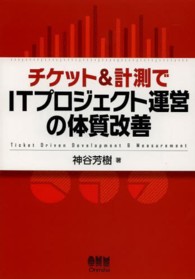- ホーム
- > 洋書
- > 英文書
- > Politics / International Relations
Full Description
Structural human rights deficiencies in the member states of the European Convention of Human Rights have caused numerous individual applications to the European Court of Human Rights and are a considerable factor in the Court's persistent overload crisis. The Pilot-Judgment Procedure was devised to tackle these structural deficiencies and has become an important instrument of the Court.
Dominik Haider examines to which extent the Pilot-Judgment Procedure is reconcilable with the European Convention on Human Rights. After an analysis of the member states' obligations to resolve structural deficiencies, the author asks if the European Court of Human Rights is empowered to take the procedural steps which are characteristic of the Pilot-Judgment Procedure. In particular, the Court's express orders are critically scrutinised.
Contents
Preface; Table of Contents; Abbreviations;
A. Introduction;
1 The Underlying Problem;
2 The Steps of Examination to be Conducted;
B. Context and Development of the Pilot-Judgment Procedure;
3 Overview;
4 Judicial Development Leading to Pilot Judgments;
5 Political Context and Development;
6 Conclusion;
C. Elements of the Pilot-Judgment Procedure;
7 Overview;
8 Definitions;
9 The Elements of the Pilot-Judgment Procedure;
10 Conclusio;
D. The Contracting States' Obligations under the Convention;
11 Overview;
12 Obligation to Implement the Convention;
13 Obligations to Abide by Judgments of the Court;
14 Pilot Judgments: A New Approach to Redress?;
E. The Court's Competences;
15 Overview;
16 Pilot Judgments and the Individual Complaints Procedure;
17 Determination of Remedial Measures;
18 Assessment of General Measures in Friendly Settlement Judgments;
19 Adjournment and Striking Out of Applications;
F. Conclusion;
Annex; 1 Pilot Judgments; 2 Index of Case-Law; 3 Literature; 4 Other Documents; Index.








